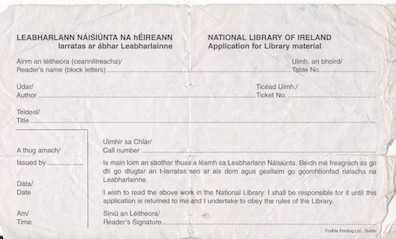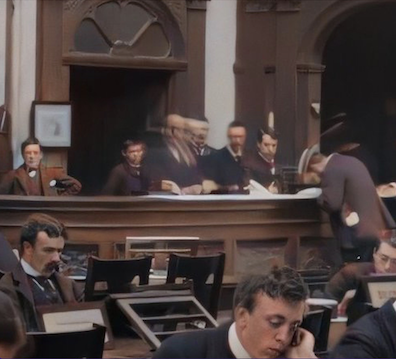Seeing Mulligan grab "a slip of paper" from John Eglinton's
desk in the library office to write down an idea, Stephen
thinks, "Take some slips from the counter going out." He is
referring not just to random pieces of paper, as in the
preceding sentence, but to ones that the library provided at
the "counter," or circulation desk. These "slips" were almost
certainly forms that patrons filled out to request books.
Their size in Joyce's era, if not their precise appearance, is
well documented.
In his autobiography Silent Years (1953), John
Francis Byrne mentions that he often sat next to Joyce
in the National Library as the writer obsessively revised
short poems. "When he had at last polished his gem to a
satisfying degree of curvature and smoothness," Joyce would
copy the final drafts down "with slow and stylish penmanship"
and jokingly hand them to Byrne as collector's items (63-64).
Byrne recalls that "The finished poems were invariably done on
slips of good quality white paper provided free and
in abundance to the readers of the National Library. The
slips were approximately 7 5/8 inches in length by 3 3/8
inches in width" (64).
Stephen is evidently in the habit of writing down his poems
on these slips even outside the library. Near the end of Proteus,
looking for some way to jot down the fragment of verse he has
just composed, he thinks, "Paper. The banknotes, blast them.
Old Deasy's letter. Here. Thanking you for the hospitality
tear the blank end off. Turning his back to the sun he bent
over far to a table of rock and scribbled words. That's
twice I forgot to take slips from the library counter."
Byrne's language might be taken to suggest that the library
generously provided sheets of blank paper to its patrons for
taking notes as they read, but such an inference would be
mistaken. In a personal communication Senan Molony notes that
throughout his experience "the National Library gently
discouraged writing at desks. Any writing instrument could be
used to mark, underline or disfigure books." If the library
had made note-taking paper available to patrons, he observes,
it would have been distributed around the reading desks, and
there would have been wastepaper baskets, neither of which
appear in contemporary photographs. The slips were available
only at the circulation "counter." Until only a couple
of years ago, Molony reports, the counter held a stack of
"slim rectangular request forms for books, backed by a carbon
card." These were "like mini notebooks, extremely useful for
jottings in everyday life."
The image of one of these recent cards displayed here shows a
shape distinctly similar to the slips of paper that Byrne
measured, though not in precisely the same ratio. It seems
likely that the library followed the same method for
requesting books throughout the intervening 120 years, but
also that the physical characteristics of the slips changed
slightly during that time. Perhaps in Joyce's era there was
not even a printed image on the front, just "good quality
white paper." But the important (though admittedly fine) point
is that what the library was providing "free and in abundance"
must have been forms intended for a single, library-specific
purpose: checking out books. Stephen, like Molony and no doubt
many other Dubliners, is creatively repurposing them.

Recent photograph of a patron's slip from the
National Library of Ireland.
Source: Senan Molony.

Colorized detail of an early 20th century
photograph of the National Library counter, showing a man
filling out a request slip. Source: Senan Molony.

Photograph by John J. Clarke ca. 1897-1904
giving another view of the counter with pile of slips visible.
Source: www.openculture.com.


